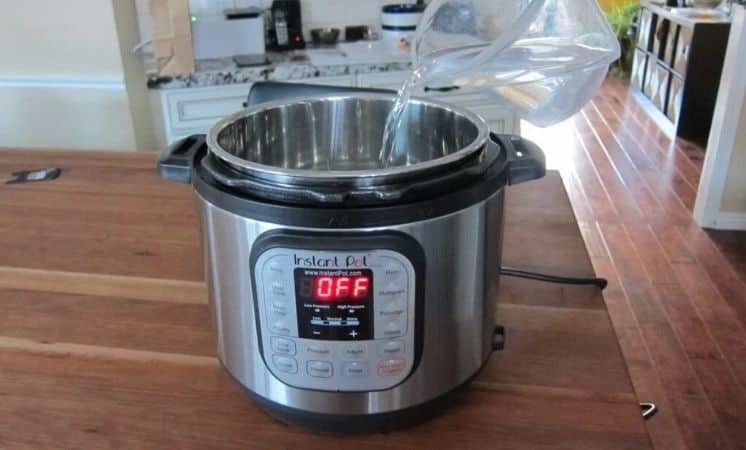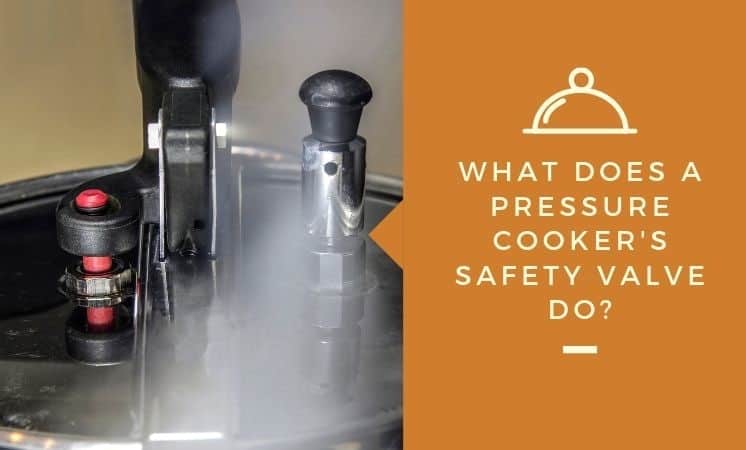Pressure cookers are both simple and complicated at the same time. From the user’s perspective, they seem quite simple – to operate. But a lot of time has been invested in creating these cookers as we know them today – with all of their safety features and automated functions. Every little part of the cooker plays an important role in keeping the user safe, cooking delicious food and ensuring the quality of the product.
In this article, I’ll cover everything you need to know about the pressure cooker’s safety valve, including problems and fixes.
Alas, to the main question.
What’s the use of a pressure cooker’s safety valve? It’s, as the name suggests, a safety mechanism. If the pressure cooker fails to release excess pressure, the inner pressure will rise above controllable levels. When that happens, the safety valve will burst and let out the excess pressure to prevent an explosion. The safety valve is commonly found on the cooker’s lid.
Pressure cookers are designed to trap the steam that is produced by the boiling liquids inside the cooker to increase the pressure inside the vessel. The cooker must, however, release some pressure when it exceeds certain limits to prevent an explosion.
This is done through a release valve, which holds a weight. When the pressure inside the cooker is high enough to lift the weight, the excess steam escapes – creating a whistling sound.
If the release valve fails to let out steam for some reason, the pressure inside the container will rise to unbearable levels and eventually cause an explosion.
That’s where the safety valve comes in.
How Does a Pressure Cooker’s Safety Valve Work?
You can find safety valves on any equipment that is used to accumulate high pressure-levels (chemical plants, gas storage tanks, pressure cookers, etc). This is a safety mechanism that keeps the object from reaching levels of pressure that it cannot contain. If it wasn’t for the safety valve, reaching said levels would otherwise result in an explosion.
But how does the safety valve do that? Here’s a simple description:
- The inner part of the safety valve (the nozzle) senses an increase in pressure inside the vessel.
- When pressure supersedes predetermined levels, the disc starts to lift and opens up an outlet for the excess pressure to escape.
- When the pressure decreases, the force of the safety valve’s spring pushes the disc back into place and closes the outlet.
This isn’t exactly the way every safety valve is designed but the main principle seems to be the same. When it comes to pressure vessels, the safety valve is known as the final safety device. It will not engage unless all other measures fail to release pressure.
What Can Cause The Safety Valve To Fuse?

Of course, while the safety valve is a fine feature to have, us users must do our best to prevent our cookers from reaching high levels of pressure. This is done by following the manufacturer’s guidelines when cooking, taking good care of our cookers, and never leave our cooker unattended.
Here’s a list of things that can cause the pressure cooker to reach maximum levels of pressure (electric pressure cookers max out at 12.5psi~ and regular stovetop pressure cookers at 15psi~).
- Overfilling the cooker: Some foods will swell when cooked, and take up more space than they initially did. The cooker should, therefore, never be loaded more than two-thirds full. The expanding ingredients may block or clog the release valve which, in turn, results in unbearable pressure levels.
- Cooking ingredients that froth: Ingredients such as pasta, beans, rice, and oatmeal froth easily when cooked. The boiled-up foam may prevent the release valve from transporting the excessive pressure out of the cooker.
- The pressure cooker is damaged: If your pressure cooker is damaged and fails to regulate pressure levels, the pressure inside the cooker can rise far beyond the cooker’s limits. This will cause the safety valve to burst and let out the excessive pressure. Safety valves and venting valves should be checked on a regular basis to ensure that they are working properly.
- There wasn’t enough liquid in the cooker: If the user hasn’t added sufficient amounts of liquid in the cooker prior to starting the cycle, the liquids inside the cooker will eventually evaporate and the cooker will start boiling dry. This can cause the temperature and pressure inside the cooker to rise above safe levels. This may cause the safety valve to fuse.
- Adjustments weren’t made when needed: Traditional stovetop pressure cookers demand the user to make manual adjustments throughout the process to regulate pressure and temperature. Electric pressure cookers handle this automatically. On a traditional pressure cooker, the user must keep track of the pressure gauge and lower the temperature when full operating pressure is reached. Continuing cooking on full operating pressure can cause pressure levels to reach unsafe levels. This, in turn, causes the fuse to blow.
- The cooker is used on large flames: If the cooker is placed on large flames, the flames will extend to the side of the cooker, this may overheat the pressure cooker and blow the fuse. Large cookers require large flames but small cookers don’t – adjust the flames according to the size of the cooker.
Can a Pressure Cooker’s Safety Valve Be Replaced?
Yes, you can replace a safety valve on a pressure cooker, and if your safety valve is damaged or out-of-function, I strongly recommend that you do so.
There are two ways of replacing the safety valve on a pressure cooker. The first method approaches the safety valve from inside the lid and the second method from the outside.
Here’s how it’s done:
- The first method, which approaches the safety valve from the outside, is done by inserting a blunt knife or turning the screw in the hole from the outside while you hold the screw on the inside. Turn the knife to turn the screw. It should loosen up eventually.
- The second method is done from inside the lid. Using a wrench or tong, turn the screw until it’s loosened up enough to remove it.
- Now insert the new safety valve and make sure it’s screwed in place.
Some models may require you to remove the handle in order to get to the actual safety valve. The methods used to replace the safety valve will, of course, vary depending on the model.
Is It Possible To Cook With a Pressure Cooker If It Has a Broken Safety Valve?
Both yes and no. But I highly advise against it. Safety valves are designed and installed for a reason. Without the safety of the valve, cooking in a pressure cooker could, potentially, have devastating consequences. It’s easily avoidable by replacing or repairing your unit. Saving a couple of dollars is nothing compared to your health and well-being.
But, to answer your question:
No, it’s not possible to cook in a pressure cooker with a missing safety valve. Without the valve, the pressure cooker will not be able to reach and maintain enough pressure to cook a meal. The absence of the valve opens up an escape route for steam, which would otherwise be trapped in the cooker.
Yes, it’s possible to cook in a pressure cooker with a flawed, damaged or defective safety valve as long as the valve is still shut and intact. I can’t stress enough how bad of an idea this is. If the valve is damaged and the cooker reaches pressure levels above predetermined limits, the valve may not be able to release the excess pressure – which will cause the cooker to explode. Superheated steam will fly from the exploded cooker and burn anything in its path.
Is It Possible To Repair a Pressure Cooker’s Safety Valve?
The best thing you can do is to get in contact with customer support if you suspect that your cooker isn’t working properly. It’s worth mentioning that the pot (without the lid) can be used as a regular pot too.
If the safety valve is damaged or broken, it should be replaced by a completely new valve. The easiest way to get a hold of a valve that suits your cooker is by contacting the company that manufactured the pressure cooker. Because these relief valves play such a vital role, it’s very important that you use the right kind of valve for your pressure cooker.
What Is a Pressure Cooker’s Safety Valve Made Of?
The safety valve is the weight that will lift when certain levels of pressure are achieved to create an escape path for the excess pressure.
When a safety valve fails to lift when predetermined pressure levels are reached, the blowout plug will self-destruct to prevent an explosion. This blowout plug, created to burst when needed, is made of hardened rubber, more specifically; either hardened neoprene or viton.

